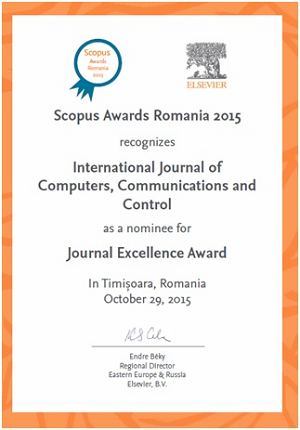Intrusion Detection in Marine Networks Based on Feature Dimension Reduction and Graph Convolution
DOI:
https://doi.org/10.15837/ijccc.2025.5.6832Keywords:
Network intrusion detection, Marine meteorological sensor network, Graph convolutional network, Feature dimensionality deductionAbstract
In response to the challenges in the realm of intrusion detection for marine meteorological sensor networks, such as difficulties in model training, inadequate detection performance, and low operational efficiency, we propose an advanced intrusion detection model. This model leverages feature dimensionality reduction, utilizing the Genetic Algorithm based on Random Forest (GARF) technique, to discern the most effective feature subset, thereby streamlining the original network intrusion detection dataset. An Approximate Nearest Neighbor (ANN) algorithm is employed to convert network traffic data into a graph structure, and the Approximate Nearest Neighbor-based Graph Convolutional Neural Network (AGCN) is constructed for traffic classification prediction on this graph-structured data. Our simulation experiments conducted on the NSL-KDD dataset have yielded positive results, demonstrating the model’s enhanced intrusion detection capabilities and efficiency, and affirming its potential to provide robust security measures for marine meteorological sensor networks.
References
Ashraf, I.; Khan, M.A.; Khan, S.U.; et al. (2022). A survey on cyber security threats in IoTenabled maritime industry, IEEE Transactions on Intelligent Transportation Systems, 24(2), 2677-2690, 2022.
Su, X.; Meng, L.; Huang, J. (2020). Intelligent maritime networking with edge services and computing capability, IEEE Transactions on Vehicular Technology, 69(11), 13606-13620, 2020. https://doi.org/10.1109/TVT.2020.3015751
Hou, T.; Xing, H.; Liang, X.; et al. (2024). Traffic flow prediction method for the intelligent marine meteorological sensor network, Ocean Engineering, 309, 118296, 2024. https://doi.org/10.1016/j.oceaneng.2024.118296
Dorle, P.K.; Ranade, S.D. (2021). Hydrology and Hydrological Information Systems (HIS) in India, International Journal for Research in Applied Science & Engineering Technology (IJRASET), 9(2), 2021. https://doi.org/10.22214/ijraset.2021.33056
Su, X.; Zhang, G.; Zhang, M.; Ye, B.; Xing, H. (2022). Intrusion Detection for Marine Meteorological Sensor Network. In 2022 IEEE Intl Conf on Parallel & Distributed Processing with Applications, Big Data & Cloud Computing, Sustainable Computing & Communications, Social Computing & Networking (ISPA/BDCloud/SocialCom/SustainCom) (pp. 190-196). IEEE, 2022. https://doi.org/10.1109/ISPA-BDCloud-SocialCom-SustainCom57177.2022.00031
Gyamfi, E.; Khan, M.A.; Khan, S.U.; et al. (2022). An adaptive network security system for IoT-enabled maritime transportation, IEEE Transactions on Intelligent Transportation Systems, 24(2), 2538-2547, 2022.
Jahanbakht, M.; Xiang, W.; Hanzo, L.; et al. (2021). Internet of underwater things and big marine data analytics-a comprehensive survey, IEEE Communications Surveys & Tutorials, 23(2), 904-956, 2021. https://doi.org/10.1109/COMST.2021.3053118
Tiwari, D.; Bhati, B.S.; Nagpal, B.; et al. (2021). An enhanced intelligent model: To protect marine IoT sensor environment using ensemble machine learning approach, Marine Engineering, 242, 110180, 2021. https://doi.org/10.1016/j.oceaneng.2021.110180
Hou, T.; Xing, H.; Liang, X.; et al. (2023). A marine hydrographic station networks intrusion detection method based on LCVAE and CNN-BiLSTM, Journal of Marine Science and Engineering, 11(1), 221, 2023. https://doi.org/10.3390/jmse11010221
Liu, W.; Zhang, G.; Su, X.; et al. (2022). Intrusion detection for maritime transportation systems with batch federated aggregation, IEEE Transactions on Intelligent Transportation Systems, 24(2), 2503-2514, 2022.
Sun, C.C.; Cardenas, D.J.S.; Hahn, A.; et al. (2020). Intrusion detection for cybersecurity of smart meters, IEEE Transactions on Smart Grid, 12(1), 612-622, 2020. https://doi.org/10.1109/TSG.2020.3010230
Kumar, P.; Kumar, S.; Kumar, A.; et al. (2021). DLTIF: Deep learning-driven cyber threat intelligence modeling and identification framework in IoT-enabled maritime transportation systems, IEEE Transactions on Intelligent Transportation Systems, 24(2), 2472-2481, 2021.
Singh, A.P.; Singh, M.D. (2014). Analysis of host-based and network-based intrusion detection system, International Journal of Computer Network and Information Security, 6(8), 41-47, 2014. https://doi.org/10.5815/ijcnis.2014.08.06
Martins, I.; Resende, J.S.; Sousa, P.R.; et al. (2022). Host-based IDS: A review and open issues of an anomaly detection system in IoT, Future Generation Computer Systems, 133, 95-113, 2022. https://doi.org/10.1016/j.future.2022.03.001
Kim, T.; Pak, W. (2023). Integrated Feature-Based Network Intrusion Detection System Using Incremental Feature Generation, Electronics, 12(7), 1657, 2023. https://doi.org/10.3390/electronics12071657
Ahmad, R.; Alsmadi, I.; Alhamdani, W.; et al. (2023). Zero-day attack detection: a systematic literature review, Artificial Intelligence Review, 56(10), 10733-10811, 2023. https://doi.org/10.1007/s10462-023-10437-z
Oliveira, N.; Praça, I.; Maia, E.; et al. (2021). Intelligent cyber attack detection and classification for network-based intrusion detection systems, Applied Sciences, 11(4), 1674, 2021. https://doi.org/10.3390/app11041674
Ahmad, Z.; Shahid Khan, A.; Wai Shiang, C.; et al. (2021). Network intrusion detection system: A systematic study of machine learning and deep learning approaches, Transactions on Emerging Telecommunications Technologies, 32(1), e4150, 2021. https://doi.org/10.1002/ett.4150
Saranya, T.; Sridevi, S.; Deisy, C.; et al. (2020). Performance analysis of machine learning algorithms in intrusion detection system: A review, Procedia Computer Science, 171, 1251-1260, 2020. https://doi.org/10.1016/j.procs.2020.04.133
Vijayanand, R.; Devaraj, D.; Kannapiran, B. (2018). Intrusion detection system for wireless mesh network using multiple support vector machine classifiers with genetic-algorithm-based feature selection, Computers & Security, 77, 304-314, 2018. https://doi.org/10.1016/j.cose.2018.04.010
Disha, R.A.; Waheed, S. (2022). Performance analysis of machine learning models for intrusion detection system using Gini impurity-based weighted random forest (GIWRF) feature selection technique, Cybersecurity, 5(1), 1, 2022. https://doi.org/10.1186/s42400-021-00103-8
Gu, J.; Lu, S. (2021). An effective intrusion detection approach using SVM with naïve Bayes feature embedding, Computers & Security, 103, 102158, 2021. https://doi.org/10.1016/j.cose.2020.102158
Ashiku, L.; Dagli, C. (2021). Network intrusion detection system using deep learning, Procedia Computer Science, 185, 239-247, 2021. https://doi.org/10.1016/j.procs.2021.05.025
Halbouni, A.; Gunawan, T.S.; Habaebi, M.H.; et al. (2022). CNN-LSTM: hybrid deep neural network for network intrusion detection system, IEEE Access, 10, 99837-99849, 2022. https://doi.org/10.1109/ACCESS.2022.3206425
Chauhan, S.; Mahmoud, L.; Gangopadhyay, S.; et al. (2022). A comparative study of LAD, CNN and DNN for detecting intrusions. In International Conference on Intelligent Data Engineering and Automated Learning (pp. 443-455). Cham: Springer International Publishing, 2022. https://doi.org/10.1007/978-3-031-21753-1_43
Ji, Z.; Gao, X. (2022). CNN-CGAN: A New Approach for Intrusion Detection Based on Generative Adversarial Networks. In International Conference on Emerging Networking Architecture and Technologies (pp. 324-335). Singapore: Springer Nature Singapore, 2022. https://doi.org/10.1007/978-981-19-9697-9_26
Mushtaq, E.; Zameer, A.; Umer, M.; et al. (2022). A two-stage intrusion detection system with auto-encoder and LSTMs, Applied Soft Computing, 121, 108768, 2022. https://doi.org/10.1016/j.asoc.2022.108768
Fu, Y.; Du, Y.; Cao, Z.; et al. (2022). A deep learning model for network intrusion detection with imbalanced data, Electronics, 11(6), 898, 2022. https://doi.org/10.3390/electronics11060898
Su, X.; Zhang, G.; Xing, H.; et al. (2023). Research on Intrusion Detection in Marine Meteorological Sensor Network Based on Balanced Generative Adversarial Networks [in Chinese], Journal of Communications, 44(4), 124-136, 2023.
Su, X.; Tian, T.; Gong, Z.; et al. (2023). Research on Intrusion Detection Methods in Marine Meteorological Sensor Networks Based on Abnormal Behavior [in Chinese], Journal of Communications, 44(7), 86-99, 2023.
Abdulhammed, R.; Musafer, H.; Alessa, A.; et al. (2019). Features dimensionality reduction approaches for machine learning based network intrusion detection, Electronics, 8(3), 322, 2019. https://doi.org/10.3390/electronics8030322
Almomani, O. (2020). A feature selection model for network intrusion detection system based on PSO, GWO, FFA and GA algorithms, Symmetry, 12(6), 1046, 2020. https://doi.org/10.3390/sym12061046
Deng, X.; Zhu, J.; Pei, X.; et al. (2022). Flow topology-based graph convolutional network for intrusion detection in label-limited IoT networks, IEEE Transactions on Network and Service Management, 20(1), 684-696, 2022. https://doi.org/10.1109/TNSM.2022.3213807
Sun, B.; Yang, W.; Yan, M.; Wu, D.; Zhu, Y.; Bai, Z. (2020). An encrypted traffic classification method combining graph convolutional network and autoencoder. In 2020 IEEE 39th International Performance Computing and Communications Conference (IPCCC) (pp. 1-8). IEEE, 2020. https://doi.org/10.1109/IPCCC50635.2020.9391542
Wang, M.; Xu, X.; Yue, Q.; et al. (2021). A comprehensive survey and experimental comparison of graph-based approximate nearest neighbor search, arXiv preprint arXiv:2101.12631, 2021. https://doi.org/10.14778/3476249.3476255
Ravipati, R.D.; Abualkibash, M. (2019). Intrusion detection system classification using different machine learning algorithms on KDD-99 and NSL-KDD datasets-a review paper, International Journal of Computer Science & Information Technology (IJCSIT), 2019. https://doi.org/10.2139/ssrn.3428211
Salih, A.A.; Abdulazeez, A.M. (2021). Evaluation of classification algorithms for intrusion detection system: A review, Journal of Soft Computing and Data Mining, 2(1), 31-40, 2021.
Additional Files
Published
Issue
Section
License
Copyright (c) 2025 Hongyan Xing, Zhiwei Ni, Wei Xu

This work is licensed under a Creative Commons Attribution-NonCommercial 4.0 International License.
ONLINE OPEN ACCES: Acces to full text of each article and each issue are allowed for free in respect of Attribution-NonCommercial 4.0 International (CC BY-NC 4.0.
You are free to:
-Share: copy and redistribute the material in any medium or format;
-Adapt: remix, transform, and build upon the material.
The licensor cannot revoke these freedoms as long as you follow the license terms.
DISCLAIMER: The author(s) of each article appearing in International Journal of Computers Communications & Control is/are solely responsible for the content thereof; the publication of an article shall not constitute or be deemed to constitute any representation by the Editors or Agora University Press that the data presented therein are original, correct or sufficient to support the conclusions reached or that the experiment design or methodology is adequate.








